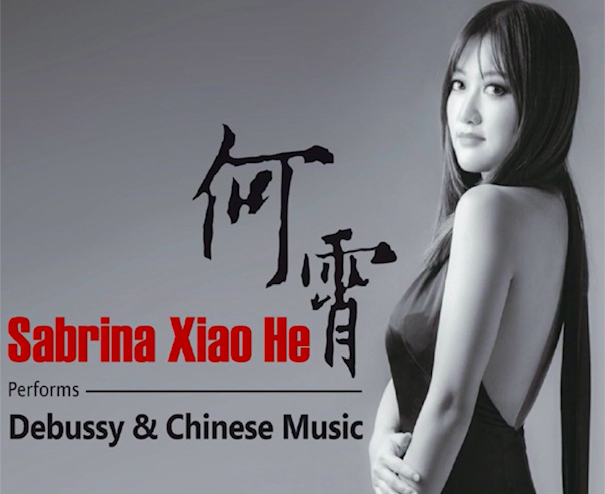Sabrina Xiao He: Performs Debussy and Chinese Music CD in Review
Sabrina Xiao He, piano
Ivory Classics CD-20190
The pairing of Chinese piano music and that of Claude Debussy is a natural one, given the French fondness for Asian influences in art and music, particularly during the late-nineteenth and early twentieth centuries, and the fondness for, and keen appreciation of, nature in most Asian cultures. Keywords are: autumn, moon, lake, water, spring, clouds, bamboo, river, and sunset.
Chinese-born Sabrina Xiao He released a CD of just this combination on the Ivory Classics label (Ivory Classics CD-20190), and the result is 70 minutes of beautiful, fluid, passionately engaged, often meditative playing. The piano sound is also beautifully engineered. Dr. Xiao He, a prodigy in her native China, moved to the United States to continue her musical education, completing her Doctor of Musical Arts degree, in piano performance at the University of Southern California Thornton School of Music 2018.
The first eight selections (Peixun Chen : Autumn Moon over the Calm Lake (1975), Mingxin Du: Dance of the Waterweeds (1959), Yiqiang Sun: Spring Dance (1980), Jianzhong Wang: Colorful Clouds Chasing the Moon (1975, Ruixing Li: Little Bamboo Raft (1973), Jianzhong Wang: Liuyang River (1972), Yinghai Li: Music at Sunset (1972), Xinghai Xian/Chengzong Ying: Ode to the Yellow River (1969)) are by twentieth-century Chinese composers, all of whom are new to me. This music is becoming much better known outside of China, thankfully, through strong advocacy such as Dr. Xiao He’s.
I’m not sure I possess the innate cultural cues necessary for the involuntary response I imagine a Chinese person might have upon hearing a folksong transformed on the piano, but I can evaluate the playing itself. Dr. Xiao He has a beautiful tone and wonderful elasticity in the phrasing, her technique is fluidity itself. Her pedaling is also superb, creating the mixtures and washes so crucial to this music’s effect. I imagine she’d be successful in most any repertoire that called for sophisticated organization of textures and sound layers. If there’s a sameness to some of the Chinese selections, it’s only because they sound somewhat influenced by previous western styles, especially French.
The second half of this fine disc consists of some early and some mature Debussy. Just one critic’s pickiness: I feel she could have utilized the second book of Images instead of the ‘early’ Debussy—its third movement Poissons d’or was even inspired by the giant koi (Japanese carp) lacquered on a prized bowl that Debussy kept on his composition desk. And the first two pieces of that set also seem much more evocative of Asia than do the Arabesques or even the Ballade slave, despite the exotic titles of the latter. Even Pagodes from Estampes would have been appropriate, if obvious.
That being said, the same qualities that animated Dr. Xiao He’s Chinese repertoire are found here as well. She gives tasteful, unexaggerated accounts of the ubiquitous First and Second Arabesques and Clair de lune. The first series of Images displays Dr. Xiao He’s command of atmosphere, and a very subtle, controlled velocity in the final Mouvement, a depiction of a mechanized society, whirling away to nothingness. The Ballade slave fares very well, Xiao He even makes it sound ‘better’ than it actually is, with her trademark liquid tone. Her Feux d’artifice sounds less violent than one usually hears it, perhaps there is even a playfulness to her approach, although I always sense menace under its surface, and I longed for a bit more of that.
All in all, this is a very beautiful disc, produced with a lot of affection and thought. It is quite an achievement, and we look forward to more.

